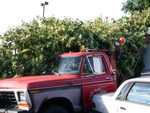
JAPANESE KNOTWEED, AN INVASIVE PLANT
by Grandpa Cliff 20 Sep 2006

Japanese Knotweed is an herbaceous perennial shrub which grows in dense clumps that crowd out other plant growth. The plant grows rapidly, and can reach a height of 10 feet or more. It can spread by horizontal underground stems called rhizomes, forming stands that can cover 1 to 3 acres in area. The rhizomes can live for decades, making Japanese Knotweed an unwelcome weed that is very difficult to eradicate.
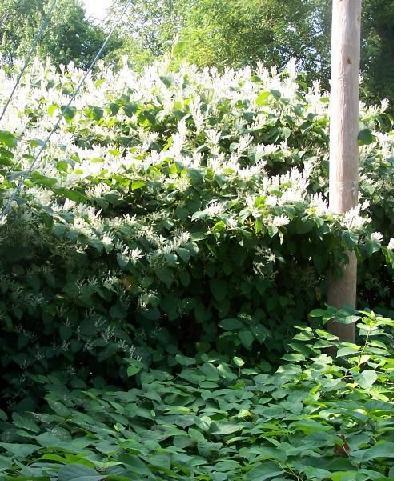
The Japanese Knotweed in the photo at the left is in full bloom, September 2006 near Albany, NY. This is on a property where a power line crosses a major road in the area. The Japanese Knotweed plants are about ten feet tall, but in the foreground of the photo the town had mowed them down, probably before they grew very tall. They are abundantly regrowing from the rhizomes. Not much else can grow in that area. [photo by Grandpa Cliff]
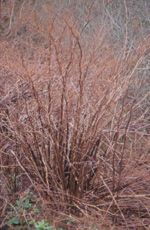
Winter in Northern United States
In northern U.S., the above-ground parts of the plant die and start to turn brown after the first frost. The dead canes remain standing throughout the winter (see right). The following Spring, new growth sprouts up from the rhizomes, and new canes grow up between the previous year's growth. Over a period of time, the dead canes weaken and collapse, covering the ground with rotting stem parts.
NATIVE RANGE
Japanese Knotweed is an Asian plant that is native to Japan, Northern China, Taiwan and Korea. It was introduced into Great Britain in 1825, then brought from there to the United States in the very late 1800s as an ornamental plant and for use in erosion control.
NAME
The scientific name is Polygonum cuspidatum. It is sometimes called Fallopia japonica, especially in Europe. Both names have been used recently by the U.S. Department of Agriculture, but Polygonum cuspidatum seems to be the preferred name. Common names for the plant are Japanese Knotweed, Japanese Bamboo, Mexican Bamboo, and many others.
STEM
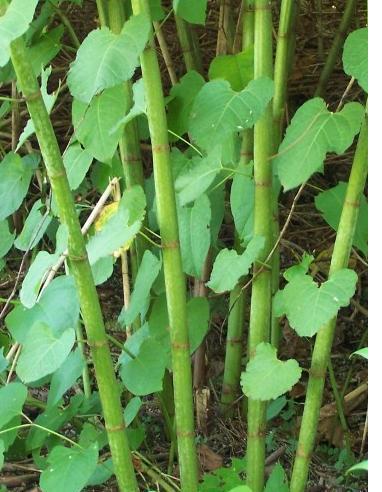
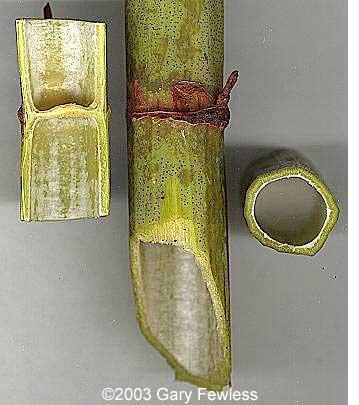
The mottled green stems of Japanese Knotweed have frequent nodes which can be recognized by their brownish color. From the nodes grow the leaves, flowers and other branches. The section of stem between the nodes is hollow, similar to bamboo, which is why the common name of the plant in some places is Japanese Bamboo or Mexican Bamboo.
[S]
[Grandpa Cliff]

Young stems of Japanese Knotweed that are growing
along the ground rather than upright into canes often
have a zig-zag appearance. The same is true of many
of the branches that come off the main stem (the cane).
In the photo, you are viewing the underside of the leaves.
You can see inflorescences growing from the axils of the
leaves. The inflorescences will be made of clusters of
numerous small white flowers. An axil is the upper (and
usually smaller) angle between a stem and the petiole of
a leaf.
[S United Kingdom]
FLOWERS
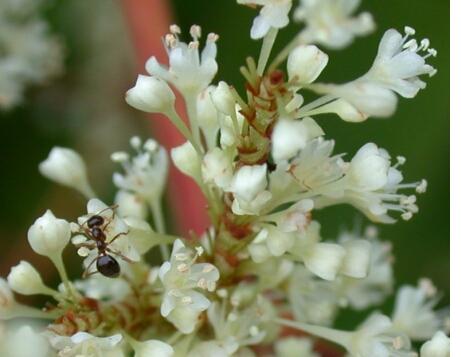
The photo shows an ant climbing among the white flowers of the Japanese Knotweed. Flying insects like bees visit the flowers for the plant's nectar. Japanese Knotweed can be an important source of nectar at a time when most other plants have stopped flowering.
The plants are in bloom in late August and September in New York State.
[S]
FRUIT
A fruit is the part of a flowering plant that contains the seeds. It does not have to be sweet or edible. Each of the Japanese Knotweed fruits in the photograph contains a single triangular seed about 1/10th of an inch long.
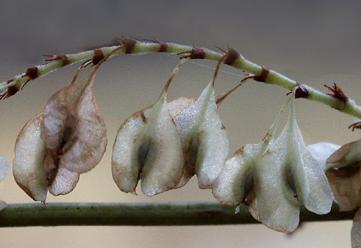 magnified view [S]
magnified view [S]
RHIZOME
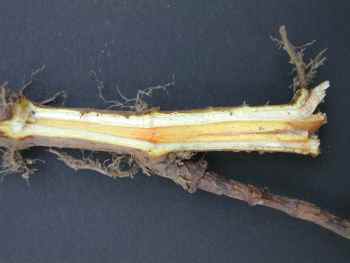 [S]
[S]
A rhizome which has been split open. It snaps like a carrot when it is fresh. The rhizomes can grow seven feet or more deep in the soil.
ERADICATION
Once Japanese Knotweed is established, it is very difficult to control. Since most of the rhizomes are connected to each other, a method of control has been devised using this knowledge. In Autumn, nutrients begin to leave the leaves before they fall off. The nutrients move down the stem to the rhizome and roots. While this movement is occuring, an herbicide can be injected near the base of the canes. It accompanies the nutrients and will kill some of the rhizomes and roots. Repeated injections may be required over a period of a few years until all rhizomes are killed.
___________________________________________________________________________
Visitors since 21
Sep 2006